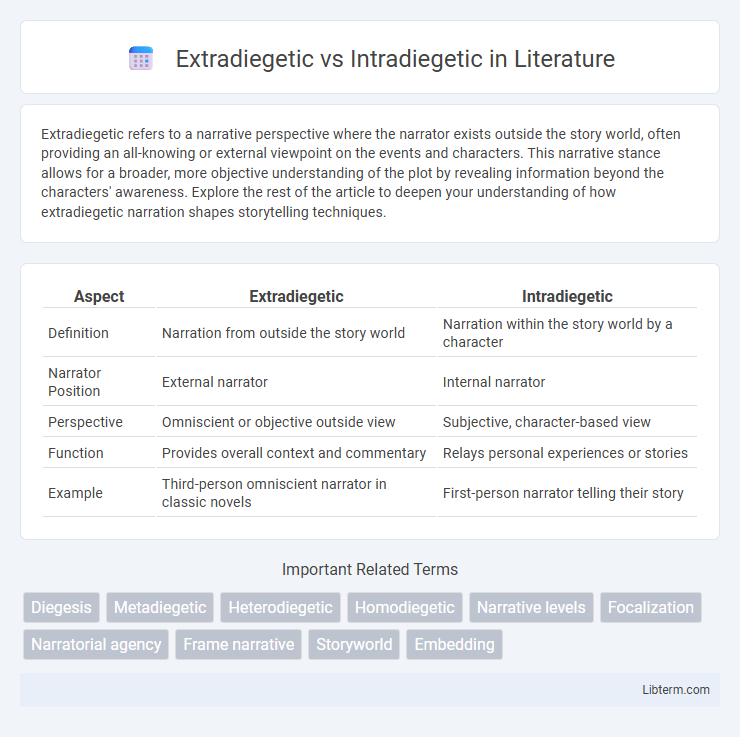Extradiegetic refers to a narrative perspective where the narrator exists outside the story world, often providing an all-knowing or external viewpoint on the events and characters. This narrative stance allows for a broader, more objective understanding of the plot by revealing information beyond the characters' awareness. Explore the rest of the article to deepen your understanding of how extradiegetic narration shapes storytelling techniques.
Table of Comparison
| Aspect | Extradiegetic | Intradiegetic |
|---|---|---|
| Definition | Narration from outside the story world | Narration within the story world by a character |
| Narrator Position | External narrator | Internal narrator |
| Perspective | Omniscient or objective outside view | Subjective, character-based view |
| Function | Provides overall context and commentary | Relays personal experiences or stories |
| Example | Third-person omniscient narrator in classic novels | First-person narrator telling their story |
Understanding Diegesis: Extradiegetic vs Intradiegetic
Extradiegetic narration occurs outside the story world, where the narrator exists beyond the characters' reality, providing an external perspective on events. Intradiegetic narration, by contrast, takes place within the story world, with a narrator who is a character or participant in the narrative, directly involved in the plot. Understanding these distinctions enhances analysis of narrative structure and the narrator's relationship to the diegesis in literary and film studies.
Defining Extradiegetic Narration
Extradiegetic narration refers to a narrative voice that exists outside the story world, often functioning as an omniscient or external narrator who provides information inaccessible to the characters. This narrative perspective contrasts with intradiegetic narration, where the narrator is a character within the story and limited to their knowledge and experiences. Extradiegetic narration enhances storytelling by offering a broader understanding of the plot, characters, and thematic elements beyond the diegetic level.
Intradiegetic Narration Explained
Intradiegetic narration occurs when the narrator is a character within the story world, sharing events from their personal perspective or knowledge. This type of narration provides intimate insight into characters' thoughts and emotions, enhancing the depth of the narrative experience. Intradiegetic narrators can be first-person protagonists or secondary characters, influencing how the plot and other characters are perceived.
Key Differences between Extradiegetic and Intradiegetic
Extradiegetic narration occurs when the narrator exists outside the story world, providing an omniscient or external perspective, while intradiegetic narration involves a narrator who is a character within the story, experiencing events firsthand. The key difference lies in narrative perspective: extradiegetic narrators do not participate in the plot, whereas intradiegetic narrators are embedded within the diegesis. This distinction shapes reader engagement and the reliability of the narrative voice in literature and film studies.
Narrative Levels in Literature and Film
Extradiegetic narrators exist outside the story world, providing an external perspective that guides the audience without participating in the narrative events. Intradiegetic narrators reside within the story, often as characters who recount events from their own viewpoint, offering limited or subjective insights into the plot. Understanding the distinction between extradiegetic and intradiegetic narration is crucial for analyzing narrative levels in literature and film, as it shapes audience engagement and the reliability of the storytelling.
Functions of Extradiegetic Narrators
Extradiegetic narrators operate outside the story world, providing an overarching perspective that guides audience interpretation and establishes narrative authority. They control the flow of information, shaping the viewer's or reader's understanding by selectively revealing or withholding details to create suspense or emphasize themes. Their detachment from the narrative events allows for commentary, background exposition, and framing that intradiegetic narrators, embedded within the story, typically cannot offer.
Role of Intradiegetic Narrators
Intradiegetic narrators actively participate in the story's events, providing a personal and subjective viewpoint that shapes the audience's understanding of the narrative world. Their position within the diegesis allows them to convey emotions, thoughts, and biases directly related to the plot and characters, enhancing the depth and reliability of the storytelling. This contrasts with extradiegetic narrators, who operate outside the story, offering a more detached and omniscient perspective.
Examples of Extradiegetic Narration in Media
Extradiegetic narration occurs when the narrator exists outside the story world, providing commentary or insight without being a character within the narrative, such as the omniscient narrator in *Jane Eyre* or the voice-over in *The Grand Budapest Hotel*. This type of narration is frequently used in documentaries, like David Attenborough's narrations in *Planet Earth*, where the speaker guides the audience without entering the diegesis. In contrast, intradiegetic narration involves narrators who are characters within the story, like Nick Carraway in *The Great Gatsby*, who recount events from their perspective inside the narrative world.
Intradiegetic Narration: Famous Case Studies
Intradiegetic narration occurs when the narrator is a character within the story, providing a subjective and immersive perspective on the events. Notable examples include Nick Carraway in F. Scott Fitzgerald's *The Great Gatsby*, who offers a personal and reflective viewpoint, and Dr. Watson in Arthur Conan Doyle's Sherlock Holmes series, whose firsthand accounts shape the reader's understanding of the mystery. These intradiegetic narrators enhance narrative depth by blending their biases and experiences with the unfolding plot, creating a rich, multifaceted storytelling experience.
Choosing the Right Narrative Level: Impacts on Storytelling
Choosing between extradiegetic and intradiegetic narrative levels significantly shapes storytelling by influencing the audience's engagement and perception. Extradiegetic narrators, who exist outside the story world, provide an overarching, often more reliable perspective, while intradiegetic narrators, embedded within the story, offer subjective, character-bound viewpoints that deepen emotional resonance. The narrative level selection impacts narrative reliability, focalization, and the degree of immersion, ultimately determining how the story's themes and plot unfold to the audience.
Extradiegetic Infographic

 libterm.com
libterm.com